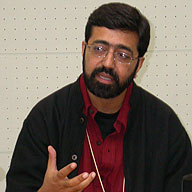An Interview with Amar Kanwar
Let’s Talk about the Future with “Poetry”

Q: What made you want to shoot this film?
AK: First, throughout the world today, especially within India, people in different countries and ethnic positions are locked into their own fixed positions, and we’re in a situation where it’s extremely difficult even for people in similar positions to communicate. So I wondered if poetry could somehow be used to break this lock. Second, we’re at a point in human history where many people are moving toward the future looking for a completely new political vocabulary and framework. I thought poetry could be an effective means for traversing different territories. The poetry treated in this work addresses various kinds of problems like prejudice, justice and cast, wealth and poverty, and race issues. Another way of putting it is looking at freedom from many different perspectives. I think that if people watching this piece are able to move geographically through different areas while simultaneously traveling through time and history via poetry, then for just a moment they’ll be able to grasp something historical and their way of thinking will become more generous. If this can happen, I think for the first time there could be a chance to have conversations talking about a new future.
Q: What is your relationship with the people who appear in the work?
AK: In most cases, during the first meeting I suddenly told them about the intentions of the piece, namely that I wanted to approach society using poetry instead of scripted dialogue to probe deeply layered possibilities. Usually people were behind the ideas and I was able to build trusting relationships in short periods of time.
Q: Images like the ones with blurred focus or high contrast were very memorable.
AK: If you ask what makes up a certain person, I think it’s a mixture of not only the reality around them at that moment, but also fragments from their past memory. Even with memories of the past I think there are different kinds of fragments, like things you recall very clearly, things you only partially remember, things that return to your memory though you’d like to forget them. So this piece is also structurally balanced with images where the exposure and focus are flawless, mixed with images that are deliberately burred to express the blurriness of abstracted memory. And I thought perhaps this piece could trigger a sense of existence including personal memories of the past for each person in the audience.
Q: It felt like using poetry brought out depth in the images.
AK: Poetry itself is extremely thick and contains various symbolic words, with hints that touch on many different things. If you film the poems and try expressing them visually, you can play endlessly like it’s an explosion, like there’s a flood with numerous images. But I felt like that would be moving away from the thickness and density possessed by poetry itself. So instead I stayed at certain location and continued filming that person’s face for a period of time, using expressions that were as controlled as possible with camera movement as slow as possible. This way, I thought maybe the thickness of the images and the thickness of the poetry would seep through to the audience.
(Compiled by Yabe Atsuko)
Interviewers: Yabe Atsuko, Hayashishita Sayo / Interpreter: Mizoguchi Akiko
Photography: Sato Akari / Video: Kondo Yoko / 2003-10-14
